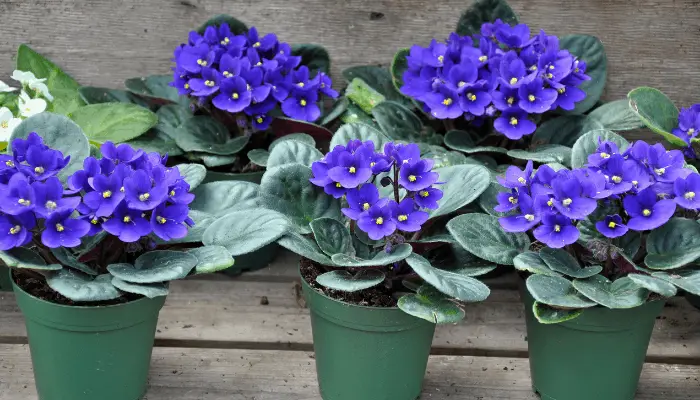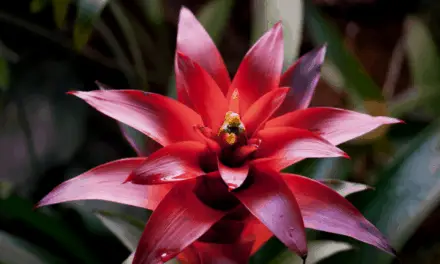If you’re a lover of African violets, you probably already know that they need some pretty specific care.
They are finicky when it comes to temperatures and watering.
And failing to provide it an environment it will thrive in could easily result in an unhealthy or wobbly African violet.
Table of Contents
Why Is My African Violet Wobbly?
If your African violet is wobbly, it’s most likely because its leaves or roots are too wet. This type of excessive moisture will create an environment where your violet’s health will go into decline and crown and root rot may take hold.
For example, if you water it from the top instead of the bottom, it can weigh down the leaves and make them droopy.
It can even cause the leaves to burn! Wetting your violet’s leaves during watering can cause rings or spots to appear.
How To Stop Your African Violet From Getting Wobbly

These plants can be a little delicate and high-maintenance, so it’s important to take some of the following tips into consideration.
Let’s look specifically at some things you can do to keep your violet in great health and stop it from getting wobbly.
Proper Watering
The most important consideration when caring for African violets is how to water them properly.
These plants are extremely sensitive when it comes to moisture levels.
Their leaves tend to sag or droop when they don’t have the correct amount of water.
Too Dry
If your violet is too dry, the leaves will droop as a result of being dehydrated.
If you’ve gone too long without watering them, they will be saggy and unable to keep their shape.
African violets need enough water for their soil to remain moist (but never soggy) in order for them to remain healthy and vibrant.
Too Wet
An African violet won’t last long if it’s being continuously overwatered.
And they don’t like to have water on their leaves.
If you continually get their leaves wet, you can expect them to sag from side to side and develop spots or rings.
How To Water Your African Violet
Proper watering is key to keeping your African violet in great health.
These plants prefer to be watered from the bottom rather than the top, which will help you to avoid the risk of getting their leaves wet, which can leave spots and burns.
Instead, place the pot in a saucer or tray that is filled with about an inch of water.
Allow it to sit in the tray long enough to soak up what water it needs (about an hour).
After that, you need to remove it so it doesn’t take on too much water.
Related Article: Why Is My African Violet Not Growing?
Watch For Root Rot
If you have a tendency to overwater your African violet, it is highly likely that it will develop some level of Pythium ultimum, or root rot.
This means that the moisture has caused a disease to grow on the roots of your plant.
It is a fungus characterized by dark roots and wilted leaves.
Watch For The First Signs Of Disease
A key identifier for root rot is a limp and wobbly African violet.
Leaves that are older will be first to droop to the sides and become wilted.
The younger leaves in the center of the plant will turn black, die and fall off.
Learning how to properly water your violet and sticking to a strict watering regime will go a long way to ensuring your plant’s health.
How To Know When Your African Violet Needs Water
Observe The Leaves
Take a look at the plant and if the center leaves look dull or droopy, it may be time to water.
If you see that the leaves look firm and shiny it indicates they are holding enough moisture and don’t need more water.
Test The Soil For Dryness
Use your finger and if the top half an inch of soil feels dry to the touch, then your African violet needs watering.
Less is more when it comes to watering violets.
Make sure the soil has dried out each time before you give it more water.
Sanitize Pots And Use Proper Potting Soil
You can also help to protect your plants against fungus and disease by only using sanitized pots and specialized potting soil for your violets.
African violets thrive in soil that is well-drained and slightly acidic.
You should be able to find a specially formulated Indoor potting mix for your African violet both locally and online.
These practices combined will go a long way to help keep your African violets healthy and happy.
Over-Fertilizing Can Cause Problems
Too much fertilizer may also lead to a wobbly African violet.
It is definitely possible to burn your plant by using too much fertilizer.
This, in turn, will result in drooping leaves and a wobbly, unhealthy plant.
One of the most important things to remember about fertilizers is that they should only be used on an as-needed basis.
They do not need to be applied to your plants on a daily or weekly basis.
Be sure to read the manufacturer’s guidelines before applying them.
There are a number of fertilizers on the market that are specifically designed for African violets.
These fertilizers tend to be gentler and more suited for keeping your violets healthy without scorching them.
Related Article: What’s The Difference Between Fertilizer And Compost?
Conclusion
When trying to keep healthy violet plants, half the battle is understanding their needs for water.
When an African violet gets wobbly it is usually a result of poor watering practices.
It’s important to give your plants the right amount of water and to allow them to dry out in between waterings.
Many gardeners shy away from growing the African violet because they can be an intimidating houseplant to keep.
They are a little more demanding than other plants, but taking the time to learn about their specific needs can be extremely rewarding and will build your confidence so you can take on more needy houseplants in the future.




